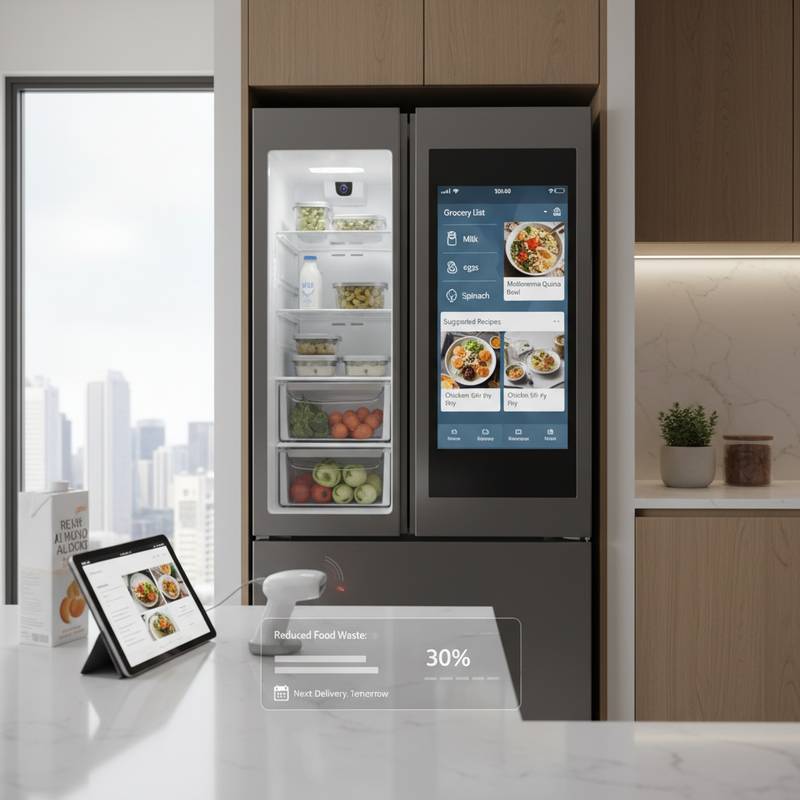How Smart Fridges Track Inventory and Automate Grocery Reorders
Smart homes integrate personal insights, predictive capabilities, and seamless connections, with the kitchen emerging as a key area of innovation. The refrigerator, traditionally focused on cooling, now functions as a digital partner that monitors inventory, proposes meals, and initiates grocery reorders. This shift from basic storage to intelligent management reflects broader trends in home automation.
Evolution from Storage to Intelligence
Conventional refrigerators prioritize food preservation through consistent cooling. Advanced models incorporate cameras, sensors, and mobile applications to catalog contents, monitor expiration dates, and align with household consumption patterns. These systems link to recipe databases, generating suggestions based on available items and transforming routine planning into an efficient, data-driven activity.
Surveys indicate that users of connected appliances prioritize time savings and waste reduction. Smart refrigerators achieve these outcomes by analyzing purchase history and usage trends. For instance, if a household frequently prepares stir-fries, the device might highlight complementary recipes or alert users to depleting oils and spices.
Mechanics of Automated Grocery Reorders
Automated reordering relies on comprehensive data collection from inventory scans and usage analytics, integrated with e-commerce platforms. The refrigerator identifies low stock in essentials like dairy or produce and either prompts user approval or executes orders via pre-configured accounts.
Samsung Family Hub models synchronize with delivery networks such as Instacart. Owners access internal views remotely via applications, compile lists, or enable recurring purchases for staples. LG ThinQ systems employ similar inventory tracking to recommend restocks, ensuring alignment with dietary needs.
Setup involves initial calibration of preferences and thresholds. Users then review proposed orders weekly, adjusting quantities or substitutions as required. This method curbs unnecessary purchases by focusing on verified needs rather than memory-based lists.
Core Technologies Driving Functionality
Interior cameras document shelf arrangements, while environmental sensors measure conditions like temperature and moisture. Machine learning processes these inputs to identify products and forecast depletion rates based on historical data.
Voice interfaces enhance usability, compatible with assistants such as Amazon Alexa or Google Assistant. Commands allow queries on remaining stock or additions to lists without manual interaction. Broader smart home ecosystems enable coordination with devices like ranges, where the refrigerator proposes menus and signals preparation starts.
Advancements continue to refine accuracy, with ongoing improvements in object recognition and predictive modeling. This interconnected framework prioritizes holistic kitchen orchestration over isolated device operations.
Practical Impacts on Daily Routines
These features resolve common household challenges, including the effort of meal ideation, the tedium of shopping, and the inefficiency of waste. By flagging expiring items and proposing recipes that incorporate them, refrigerators promote resourcefulness.
Purchase pattern analysis ensures acquisitions match actual consumption, avoiding overstock. Synchronization with schedules or wellness objectives allows customized suggestions, such as quick-prep options for weekdays or nutrient-focused plans.
Consider a scenario on a hectic night: the refrigerator displays feasible dinners from current stock, including preparation guides. Morning alerts confirm incoming deliveries, streamlining the day and redirecting energy toward family or professional priorities.
Key Challenges and Solutions
Initial costs exceed those of standard units, potentially deterring adoption among budget-conscious buyers. Not every feature may justify the premium for all users, so evaluating specific needs proves essential before purchase.
Reliable internet supports reordering functions, with service availability varying by region. Manufacturers mitigate disruptions through offline modes for basic tracking and partnerships expanding coverage.
Data privacy warrants attention, given the intimate details of consumption habits. Companies implement robust encryption, granular consent options, and clear policies to empower users. Evolving regulations and industry guidelines further safeguard information as adoption grows.
Leading Models and Innovations
Prominent examples demonstrate practical applications. Samsung Family Hub facilitates list creation, camera-based checks, and direct service links for effortless fulfillment. LG InstaView ThinQ tailors recipe outputs to health profiles and collaborates with cookware for sequenced cooking.
Whirlpool integrations leverage voice commands for list maintenance and idea generation. Emerging ventures like Whisk and Yummly bridge recipes with suppliers via APIs, enabling fridge-compatible enhancements.
To integrate, select models compatible with existing ecosystems. Begin with manual inventory entry to train algorithms, then activate notifications before full automation.
Advantages for Health and Sustainability
These appliances foster informed decisions that support wellness and environmental responsibility. Inventory oversight encourages portion control and creative reuse of remnants, curbing discard rates.
Nutritional logging prompts balanced selections, with alerts for variety or moderation. Optimized cooling adjusts to patterns, conserving energy, while door-open warnings prevent inefficiencies.
In aggregate, these elements cultivate eco-friendly practices, from minimized spoilage to precise ordering that reduces packaging excess.
Steps to a Connected Kitchen Future
Kitchens serve as communal centers, and intelligent tools enhance their vitality. Refrigerators transition to collaborative allies, nurturing routines that prioritize health and efficiency.
Automation in planning and procurement marks an entry point to broader integration. Consumers benefit by aligning devices with current services, testing incremental features to build familiarity.
This progression emphasizes fluid integration over isolated tech, yielding kitchens that adapt intuitively to lifestyle demands.
